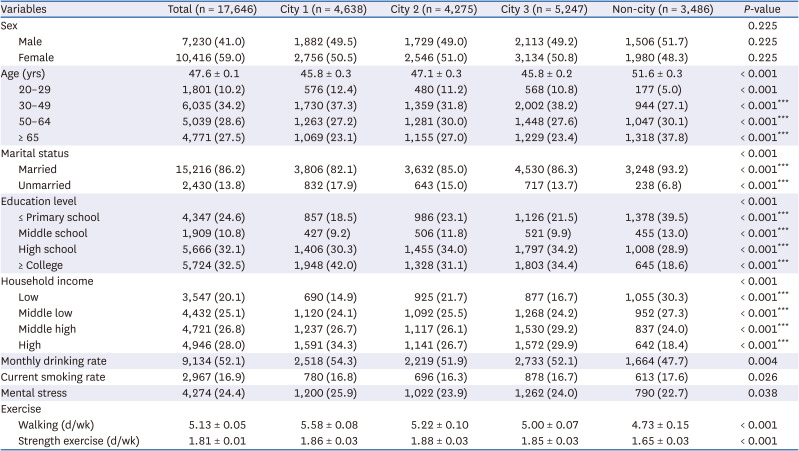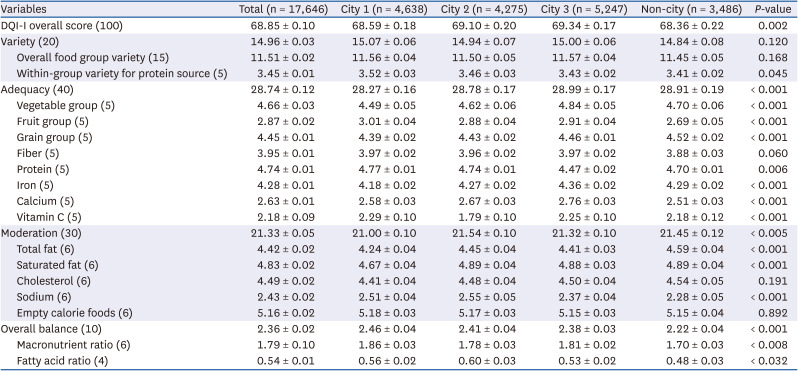1. Lee EH. Effect of the adult’s health behaviors on disease of circulation system. J Korean Soc Hyg Sci. 2009; 15:153–161.
2. Cho IY, Lee KM, Lee Y, Paek CM, Kim HJ, Kim JY, Lee K, Han JS, Bae WK. Assessment of dietary habits using the diet quality index-international in cerebrovascular and cardiovascular disease patients. Nutrients. 2021; 13:542. PMID:
33562317.

3. Cho TY, Cho HC, Hong SY, Song YK, Lim HH. Correlation study between obesity and cardiovascular risk factors. J Korean Med Obes Res. 2004; 4:33–43.
4. Ro YM. Metabolic syndrome and cardiovascular disease. J Korea Assoc Health Promot. 2004; 2:71–76.
5. Korean Statistical Information Service. Annual report on the cause of death statistics [Internet]. Daejeon: Statistics Korea;2020. cited 2021 July 1. Available from:
http://kosis.kr.
6. Haijing T, Guo C, Yu K, Xu Y. Application of data science technology on research of circulatory system disease prediction based on a prospective cohort. Algorithms. 2018; 11:162.

7. Braveman PA, Kumanyika S, Fielding J, Laveist T, Borrell LN, Manderscheid R, Troutman A. Health disparities and health equity: the issue is justice. Am J Public Health. 2011; 101(Suppl 1):S149–S155. PMID:
21551385.

8. US Department of Health and Human Services. Office of Disease Prevention and Health Promotion. Healthy People 2010: Understanding and Improving Health. 2nd ed. Washington, D.C.: US Government Printing Office;2000.
9. Korean Law Information Center. Regional Public Health Act [Internet]. Sejong: Korean Law Information Center;2021. cited 2021 July 1. Available from:
https://law.go.kr.
10. Ministry of Health and Welfare. Health plan 2020 [Internet]. Sejong: Ministry of Health and Welfare;2020. cited 2021 July 1. Available from:
https://khealth.or.kr/healthplan.
11. Lee JH. The regional health inequality, and individual and neighborhood level health determinants. Health Soc Welf Rev. 2016; 36:345–384.
12. Lee MS. Health Inequalities among Korean adults - socioeconomic status and residential area differences. Korean J Sociol. 2005; 39:183–209.
13. Kim I, Bahk J, Kim YY, Lee J, Kang HY, Lee J, Yun SC, Park JH, Shin SA, Khang YH. Prevalence of overweight and income gaps in 245 districts of Korea: comparison using the National Health Screening Database and the Community Health Survey, 2009–2014. J Korean Med Sci. 2018; 33:e3. PMID:
29215812.

14. Park JW. Socioeconomic inequalities in health at the regional level in Korea. Health Welf Policy Forum. 2018; 260:7–19.
15. Kang HJ, Kwon SM. Regional disparity of cardiovascular mortality and its determinants. Health Policy Manag. 2016; 26:12–23.

16. Kant AK. Indexes of overall diet quality: a review. J Am Diet Assoc. 1996; 96:785–791. PMID:
8683010.
17. Gerber M. The comprehensive approach to diet: a critical review. J Nutr. 2001; 131(Suppl):3051S–3055S. PMID:
11694647.

18. Hu FB. Dietary pattern analysis: a new direction in nutritional epidemiology. Curr Opin Lipidol. 2002; 13:3–9. PMID:
11790957.

19. Oh SY. Analysis of methods on dietary quality assessment. Korean J Community Nutr. 2000; 5(Suppl 2):362–367.
20. Patterson RE, Haines PS, Popkin BM. Diet quality index: capturing a multidimensional behavior. J Am Diet Assoc. 1994; 94:57–64. PMID:
8270756.

21. Kim S, Haines PS, Siega-Riz AM, Popkin BM. The Diet Quality Index-International (DQI-I) provides an effective tool for cross-national comparison of diet quality as illustrated by China and the United States. J Nutr. 2003; 133:3476–3484. PMID:
14608061.

22. Son JH, Choe HS, Hwang JY, Song TJ, Chang YK, Kim YJ, Kim YR. Association between intakes of minerals (potassium, magnesium, and calcium) and diet quality and risk of cerebral atherosclerosis in ischemic stroke patients. J Nutr Health. 2015; 48:167–179.

23. Willet W.
HK Moon
. Nutritional Epidemiology. 3rd ed. Paju: Kyomunsa;2013. p. 333.
24. Grundy SM, Cleeman JI, Daniels SR, Donato KA, Eckel RH, Franklin BA, Gordon DJ, Krauss RM, Savage PJ, Smith SC Jr, et al. Diagnosis and management of the metabolic syndrome: an American Heart Association/National Heart, Lung, and Blood Institute Scientific Statement. Circulation. 2005; 112:2735–2752. PMID:
16157765.
25. Lee SY, Park HS, Kim DJ, Han JH, Kim SM, Cho GJ, Kim DY, Kwon HS, Kim SR, Lee CB, et al. Appropriate waist circumference cutoff points for central obesity in Korean adults. Diabetes Res Clin Pract. 2007; 75:72–80. PMID:
16735075.

26. House JS, Lepkowski JM, Kinney AM, Mero RP, Kessler RC, Herzog AR. The social stratification of aging and health. J Health Soc Behav. 1994; 35:213–234. PMID:
7983335.

27. Frank LD, Andresen MA, Schmid TL. Obesity relationships with community design, physical activity, and time spent in cars. Am J Prev Med. 2004; 27:87–96. PMID:
15261894.

28. Krist AH, Davidson KW, Mangione CM, Barry MJ, Cabana M, Caughey AB, Donahue K, Doubeni CA, Epling JW Jr, Kubik M, et al. Behavioral counseling interventions to promote a healthy diet and physical activity for cardiovascular disease prevention in adults with cardiovascular risk factors: US Preventive Services Task Force Recommendation Statement. JAMA. 2020; 324:2069–2075. PMID:
33231670.

29. Huang PL. A comprehensive definition for metabolic syndrome. Dis Model Mech. 2009; 2:231–237. PMID:
19407331.

30. Oh JS, Kim H, Kim KN, Chang N. Relationship between fruit and fish intakes and cardiovascular disease risk factors in Korean women with type 2 diabetes mellitus: based on the 4th and 5th Korea National Health and Nutrition Examination Surveys. J Nutr Health. 2016; 49:304–302.

31. Temple NJ. Fat, sugar, whole grains and heart disease: 50 years of confusion. Nutrients. 2018; 10:39. PMID:
29300309.

32. Kim S, Moon S, Popkin BM. The nutrition transition in South Korea. Am J Clin Nutr. 2000; 71:44–53. PMID:
10617945.

33. Song Y, Joung H. A traditional Korean dietary pattern and metabolic syndrome abnormalities. Nutr Metab Cardiovasc Dis. 2012; 22:456–462. PMID:
21215606.

34. Kang HJ, Kwon S. Regional disparity of cardiovascular mortality and its determinants. Health Policy Manag. 2006; 26:12–23.

35. Lim S, Jang HC, Lee HK, Kimm KC, Park C, Cho NH. A rural-urban comparison of the characteristics of the metabolic syndrome by gender in Korea: the Korean Health and Genome Study (KHGS). J Endocrinol Invest. 2006; 29:313–319. PMID:
16699297.

36. Korean Society for Equity in Health. Regional health disparity profiles [Internet]. Seoul: Korean Society for Equity in Health;2018. cited 2021 July 1. Available from:
http://healthequity.or.kr.
37. Chung SJ, Han YS, Lee SI, Kang SH. Urban and rural differences in the prevalence of gender and age specific obesity and related health behaviors in Korea. J Korean Med Sci. 2005; 20:713–720. PMID:
16224141.

38. Kang M, Joung H, Lim JH, Lee YS, Song YJ. Secular trend in dietary patterns in a Korean adult population, using the 1998, 2001, and 2005 Korean National Health and Nutrition Examination Survey. Korean J Nutr. 2011; 44:152–161.

39. Ha K, Song Y, Kim HK. Regional disparities in the associations of cardiometabolic risk factors and healthy dietary factors in Korean adults. Nutr Res Pract. 2020; 14:519–531. PMID:
33029291.

40. Lee H, Kim BH. Physical activity disparities by socioeconomic status among metabolic syndrome patients: the Fifth Korea National Health and Nutrition Examination Survey. J Exerc Rehabil. 2016; 12:10–14. PMID:
26933654.

41. Lee J, Sa J. Regional disparities in healthy eating and nutritional status in South Korea: Korea National Health and Nutrition Examination Survey 2017. Nutr Res Pract. 2020; 14:679–690. PMID:
33282128.

42. Lee YJ, Song S, Song Y. High-carbohydrate diets and food patterns and their associations with metabolic disease in the Korean population. Yonsei Med J. 2018; 59:834–842. PMID:
30091316.

43. Kwon JH, Shim JE, Park MK, Paik HY. Evaluation of fruits and vegetables intake for prevention of chronic disease in Korean adults aged 30 years and over: using the third Korea National Health and Nutrition Examination Survey (KNHANES III), 2005. Korean J Nutr. 2009; 42:146–157.










 PDF
PDF Citation
Citation Print
Print



 XML Download
XML Download